Research on Windage Yaw Flashovers of Transmission Lines under Wind and Rain Conditions
Abstract
:1. Introduction
2. Windage Yaw Flashover Analysis Method
2.1. The Proposed Method
2.2. Simulation of Wind Loads
2.3. Calculation of Rain Loads
2.4. Calculation of Windage Yaw
2.4.1. Calculation of Insulator String Windage Yaw
2.4.2. Calculation of Conductor/Ground Wire Windage Yaw
2.5. Flashover Analysis
3. Case Study
3.1. Wind and Rain Load of the Rammasun
3.2. Modeling of the Tower-Line System
3.3. Windage Yaw Flashover Analysis
4. Conclusions and Future Study
- The analysis of transmission lines windage yaw flashovers was conducted using a creative systematic method proposed in the paper. The first step was to simulate the average wind, fluctuating wind, and accompanying rain loads. Then windage yaw was calculated using the finite element method with tower-line system model built up. Finally, windage flashovers danger was evaluated according to the safety factor, R, which compares the breakdown voltage of the minimum clearance, Uf, and the maximum working voltage, Umax.
- The YanMeng-PSO algorithm was creatively used to improve the simulation accuracy of average wind speed. Additionally, a new approach named KNM was proposed to calculate clearance of conductors/ground wires under strong wind and rain conditions.
- According to the analysis results of the case study, safety factor, R, significantly reduced with rain effect. It dropped down to 1.6531 from 2.4751 for conductors/ground wires while that of insulator strings dropped down to 1.9735 from 2.5721. Therefore, it can be concluded that the heavy rain along with the strong wind has significant impact on transmission line windage yaw in two aspects. One is that raindrops increase the load acting on tower-line system, the other is that raindrops reduce the breakdown voltage of clearance by changing the ambient electric field distribution. The rain effect requires more consideration when it comes to transmission line design. However, it is quite insufficient in the present design code. The design clearance (including interphase clearance and clearance between insulator string to tower) requires appropriate increment to enhance the capacity of lines against windage yaw under wind and rain conditions.
- In the case study results, the RMS of the minimum R value of insulator string was 1.9735, greater than the R of conductors/ground wires, 1.6531. Moreover, the amount of R peaks below the safety criterion for conductors/ground wires was 34, more than that for insulator string, 29. The conclusion is thus drawn that conductors/ground wires suffer more severe windage yaw flashover than insulator strings. There are several ways to reduce the conductors/ground wires windage yaw flashovers. On the one hand, an anti-galloping device such as an interphase spacer is an effective solution reducing the swing of wires. Moreover, reasonable conductor arrangement in design phase and regular measurements and adjustments of conductor sag in maintenance phase are required to ensure that the interphase clearance is within safe arrangement.
Author Contributions
Funding
Acknowledgments
Conflicts of Interest
Nomenclature:
| ar | percentage of raindrops per unit volume of air at a certain rainfall intensity |
| Br | effective width of the object impacted |
| B | Holland pressure profile parameter |
| Bind | the best B value ever found in history for particle i |
| Bi | B value for the particle i in the current iteration |
| Bi′B | value for the particle i in the last iteration |
| Bswm | the best B value ever found in history for the whole swarm |
| cita | inertia constant |
| cind | constant of individual experience |
| cswm | constant of swarm experience |
| d1 | clearance of conductor suspension point to cross-arm |
| d2 | clearance of conductor suspension point to tower body |
| dmin,p-p | the minimum clearance of two phase conductor key nodes for a KNG |
| dmin,p-g | the minimum clearance of phase conductor key node to ground wire key node for a KNG |
| fc | Coriolis force parameter |
| Ft | boundary layer friction force |
| F | objective function value for a particle |
| Gv | vertical load of fittings and insulator string |
| Gh | horizontal load of fittings and insulator string |
| k | a unit vector |
| k | surface frictional drag coefficient |
| n | fluctuating wind frequency in Hz |
| kr | coefficient of rain effect |
| L | length of cross-arm |
| l | length of insulator string |
| P0 | typhoon center pressure |
| rind | a random value for individual experience |
| rswm | a random value for swarm experience |
| Rm | the maximum wind speed radius |
| Sv | fluctuating wind power spectrum in m2/s |
| U50% | voltage with a breakdown probability of 50% |
| Uf | break down voltage with rain effect correction |
| vt | simulated average wind speed |
| vr | real-time measured average wind speed |
| vt | typhoon wind speed |
| vg | gradient wind speed |
| vf | surface friction wind speed |
| V10 | average wind speed at 10 m height |
| Vrs | speed of the droplet movement before impinging the tower and wires |
| Wv | vertical load of conductor |
| Wh | horizontal load of conductor |
| z0 | equivalent roughness length |
| z0ind | the best z0 value ever found in history for particle i |
| z0i | z0 value for the particle i in the current iteration |
| z0i′ | z0 value for the particle i in the last iteration |
| z0swm | the best z0 value ever found in history for the whole swarm |
| Ψt | simulated average wind direction |
| ΔBi | adjustment of parameter B for particle i in the current iteration |
| ΔBi′ | adjustment of parameter B for particle i in the last iteration |
| Δz0i | adjustment of parameter z0 for particle i in the current iteration |
| Δz0i′ | adjustment of parameter z0 for particle i in the last iteration |
| α | angle between tower outline and the ground |
| θ | angle between the wind and the transmission line |
| Θr | real-time measured average wind direction |
| ρr | rainwater density |
| ρa | air density |
References
- Xiao, F.J.; Xiao, Z.N. Characteristics of tropical cyclones in China and their impacts analysis. Nat. Hazards 2010, 54, 827–837. [Google Scholar] [CrossRef]
- Deng, H.Z.; Xu, H.J.; Duan, C.Y.; Jin, X.H.; Wang, Z.H. Experimental and numerical study on the responses of a transmission tower to skew incident winds. J. Wind Eng. Ind. Aerodyn. 2016, 157, 171–188. [Google Scholar] [CrossRef] [Green Version]
- Yang, S.C.; Hong, H.P. Nonlinear inelastic responses of transmission tower-line system under downburst wind. Eng. Struct. 2016, 123, 490–500. [Google Scholar] [CrossRef]
- An, L.Q.; Guan, Y.Y.; Zhu, Z.J.; Wu, J.; Zhang, R.L. Structural failure analysis of a river-crossing transmission line impacted by the super typhoon Rammasun. Eng. Fail. Anal. 2019, 104, 911–931. [Google Scholar] [CrossRef]
- An, L.Q.; Wu, J.; Zhang, Z.Q.; Zhang, R.L. Failure analysis of a lattice transmission tower collapse due to the super typhoon Rammasun in July 2014 in Hainan Province, China. J. Wind Eng. Ind. Aerodyn. 2018, 182, 295–307. [Google Scholar] [CrossRef]
- Liu, X.H.; Yan, B.; Lin, X.S.; Li, W.Y. Numerical simulation of windage yaw of 500KV UHV transmission lines. Eng. Mech. 2009, 33, 244–249. [Google Scholar] [CrossRef]
- Yamagata, Y.; Oe, A.; Miyake, K.; Aihara, Y.; Shindo, T. Phase-to-Ground and Phase-to-Phase Sparkover Characteristics of External Insulation at the Entrance of a UHV Substation. IEEE Trans. Power Deliv. 2002, 17, 223–232. [Google Scholar] [CrossRef]
- Hu, Y.; Wang, L.N.; Shao, K.W.; Liu, K.; Luo, C.L.; Chen, S.J.; Geng, C.Y. Influence of Rain and Wind on Power Frequency Discharge Characteristic of Conductor-to-tower Air Gap. High Volt. Eng. 2008, 34, 845–850. [Google Scholar] [CrossRef]
- Yan, B.; Lin, X.S.; Luo, W.; Chen, Z.D.; Liu, Z.Q. Numerical Study on Dynamic Swing of Suspension Insulator String in Overhead Transmission Line under Wind Load. IEEE Trans. Power Deliv. 2010, 25, 248–259. [Google Scholar] [CrossRef]
- Zhou, C.; Yin, J.Q.; Liu, Y.B. Large Swing Behavior of Overhead Transmission Lines under Rain-Load Conditions. Energies 2018, 11, 1092. [Google Scholar] [CrossRef]
- Meng, Y.; Matsui, M.; Hibi, K. An analytical model for simulation of the wind field in a typhoon boundary layer. J. Wind Eng. Ind. Aerodyn. 1995, 56, 291–310. [Google Scholar] [CrossRef]
- Meng, Y.; Matsui, M.; Hibi, K. A numerical study of the wind field in a typhoon boundary layer. J. Wind Eng. Ind. Aerodyn. 1997, 67, 437–448. [Google Scholar] [CrossRef]
- Holland, G.J. An analytic model of the wind and pressure profiles in hurricanes. Mon. Weather Rev. 1980, 108, 1212–1218. [Google Scholar] [CrossRef]
- Tsiptsis, I.N.; Liimatainen, L.; Kotnik, T.; Niiranen, J. Structural optimization employing isogeometric tools in Particle Swarm Optimizer. J. Build. Eng. 2019, 24, 100761:1–100761:12. [Google Scholar] [CrossRef]
- Choi, E.C.C. Simulation of wind-driven-rain around a building. J. Wind Eng. Ind. Aerodyn. 1993, 46, 721–729. [Google Scholar] [CrossRef]
- Choi, E.C.C. Determination of wind-driven-rain intensity on building faces. J. Wind Eng. Ind. Aerodyn. 1994, 51, 55–69. [Google Scholar] [CrossRef]
- Marshall, J.S.; Palmer, W.M. The distribution of raindrops with size. J. Atmos. Sci. 1948, 5, 165–166. [Google Scholar] [CrossRef]
- China Electricity Council. GB 50545-2010 Code for Construction and Acceptance of 110kV-750kV Overhead Transmission Line; China Planning Press: Beijing, China, 2010. [Google Scholar]
- St. Clair, J.G. Clearance calculations of conductors to buildings. IEEE Trans. Power Deliv. 1997, 12, 979–984. [Google Scholar] [CrossRef]
- Wang, S.X. Study on Calculation of Anti-Windage Yaw Flashover Performance for UHV Transmission Line; Southwest Jiaotong University: Chengdu, China, 2008. [Google Scholar] [CrossRef]
- Geng, C.Y.; Wei, D.; He, X. Raining Effect on Frequency Breakdown Voltage. High Volt. Appar. 2010, 46, 103–105. [Google Scholar] [CrossRef]
- China Weather Typhoon Net. Available online: http://typhoon.weather.com.cn/ (accessed on 6 September 2019).
- Mara, T.G.; Hong, H.P. Effect of wind direction on the response and capacity surface of a transmission tower. Eng. Struct. 2013, 57, 493–501. [Google Scholar] [CrossRef]
- Lou, W.J.; Xia, L.; Jiang, Y.; Jin, X.H.; Wang, Z.H. Wind-induced response and wind load factor of transmission tower under terrain B wind field and typhoon wind field. J. Vib. Shock 2013, 32, 13–17. [Google Scholar] [CrossRef]
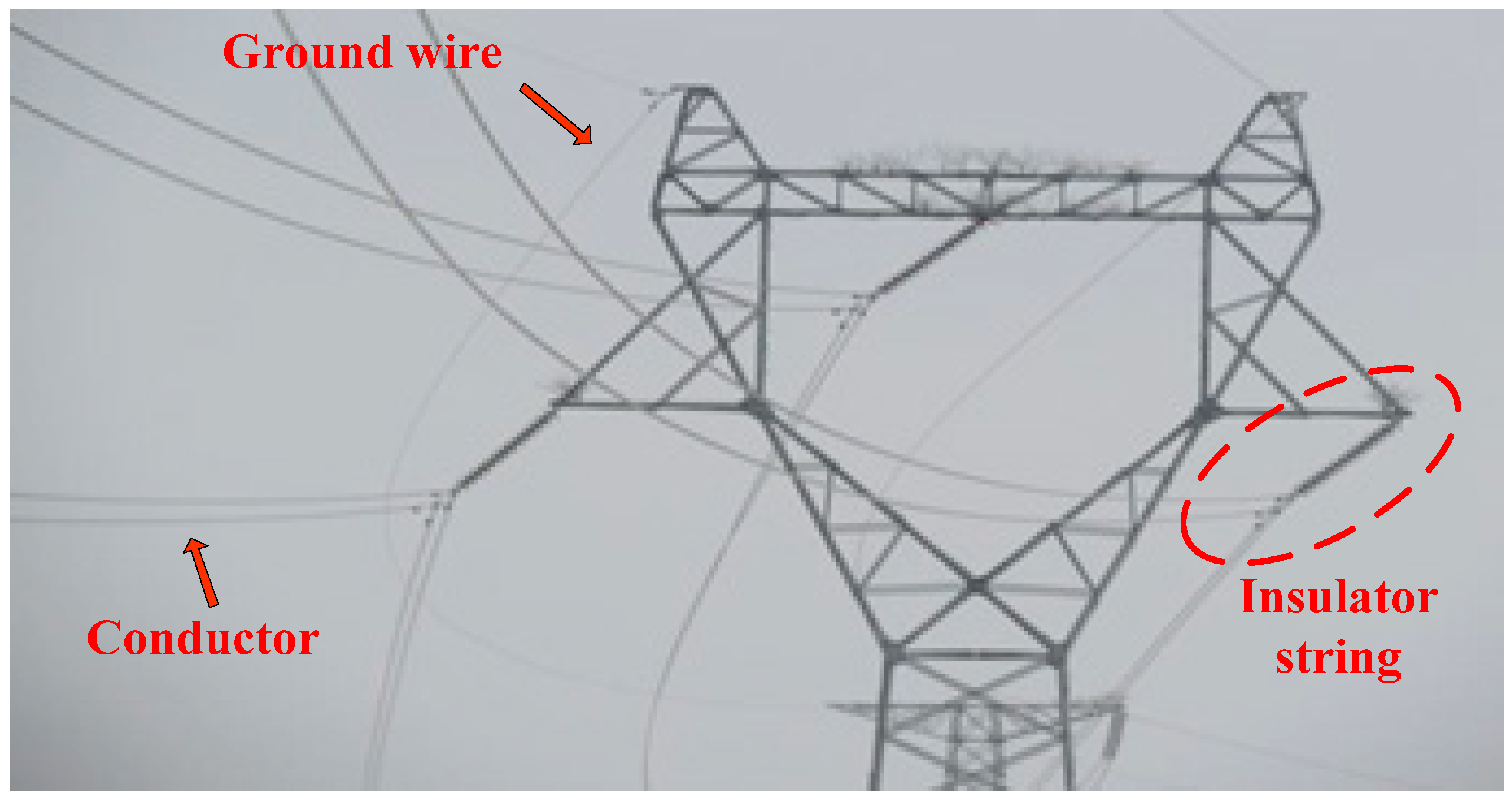
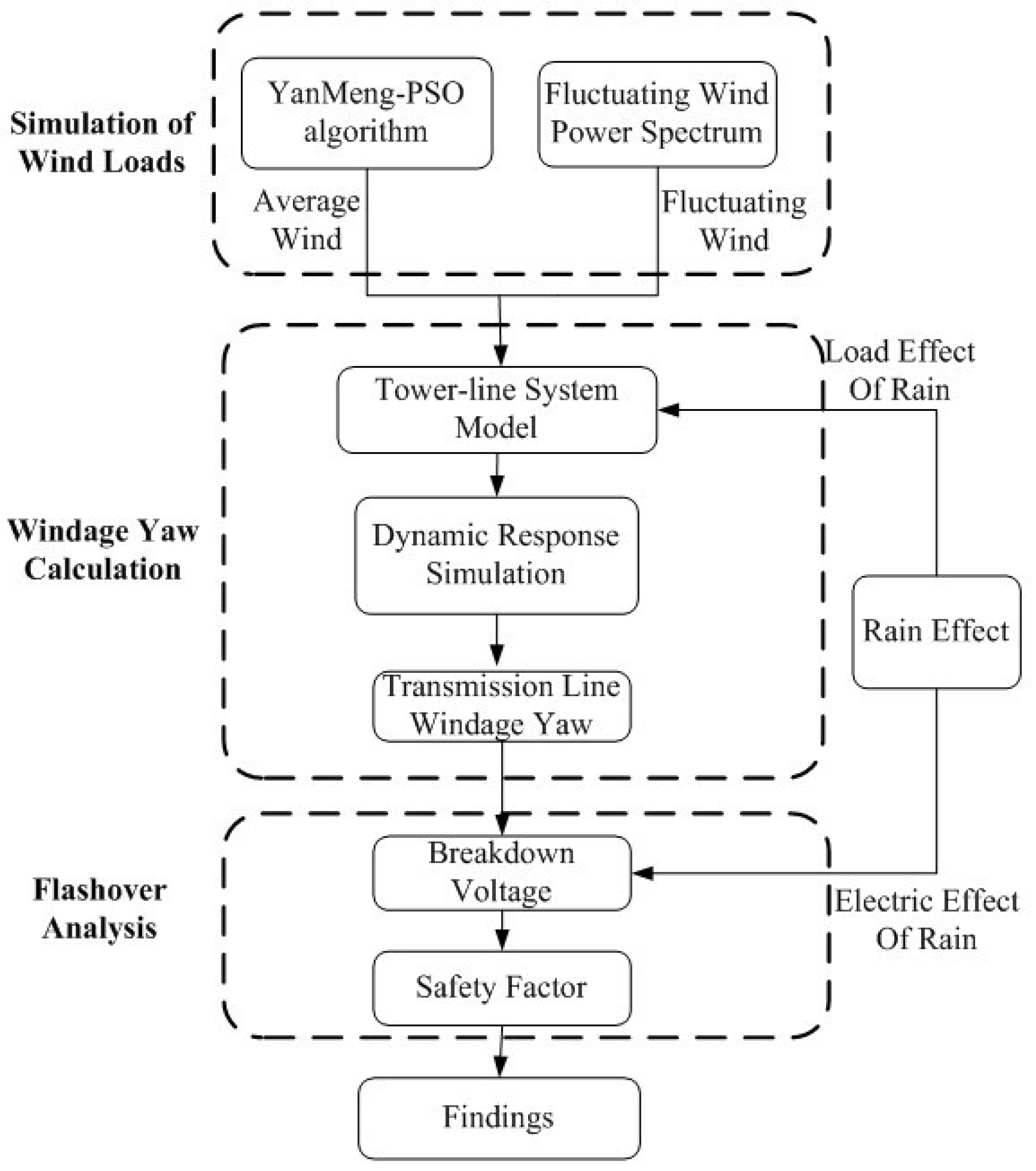


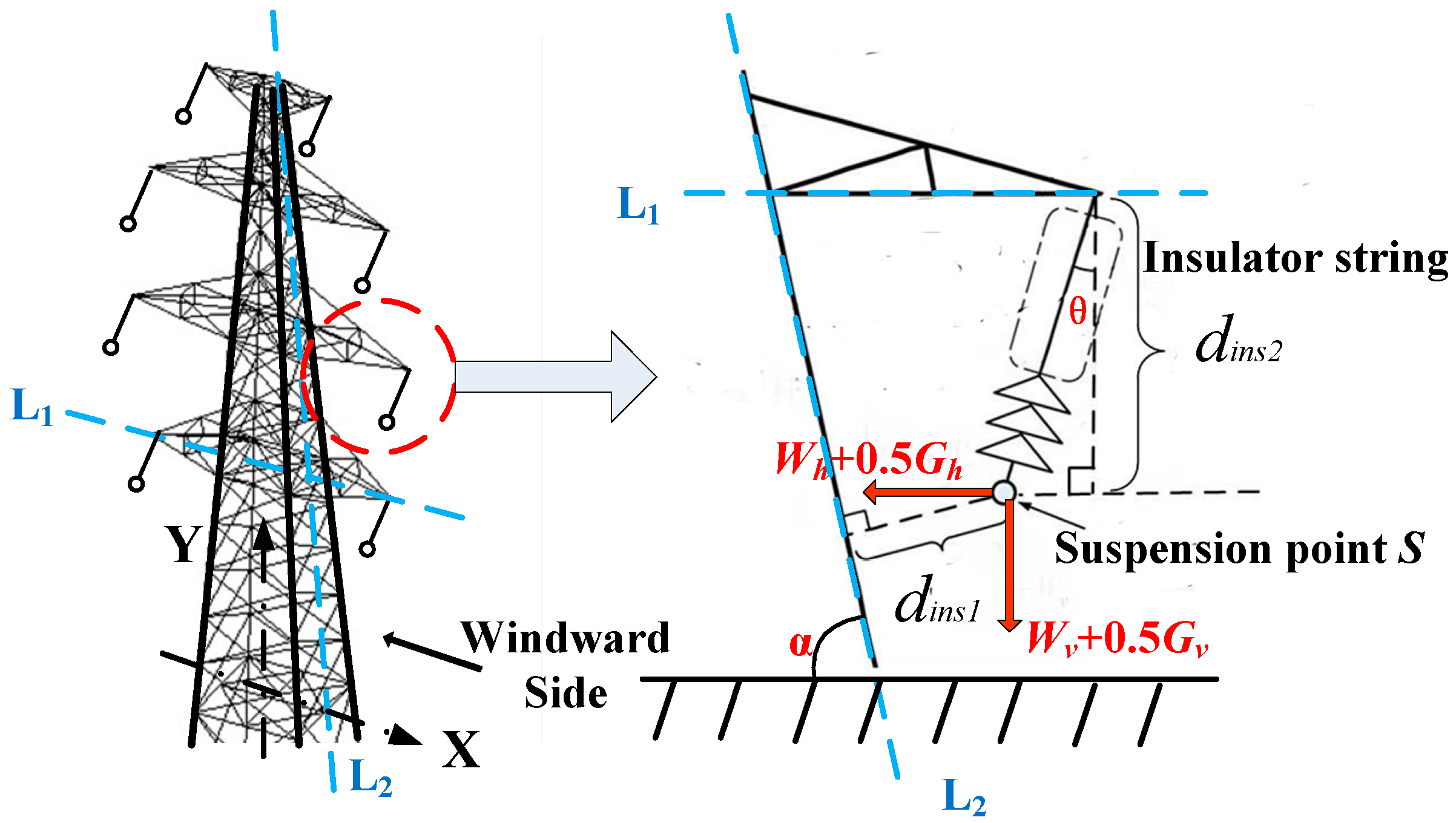



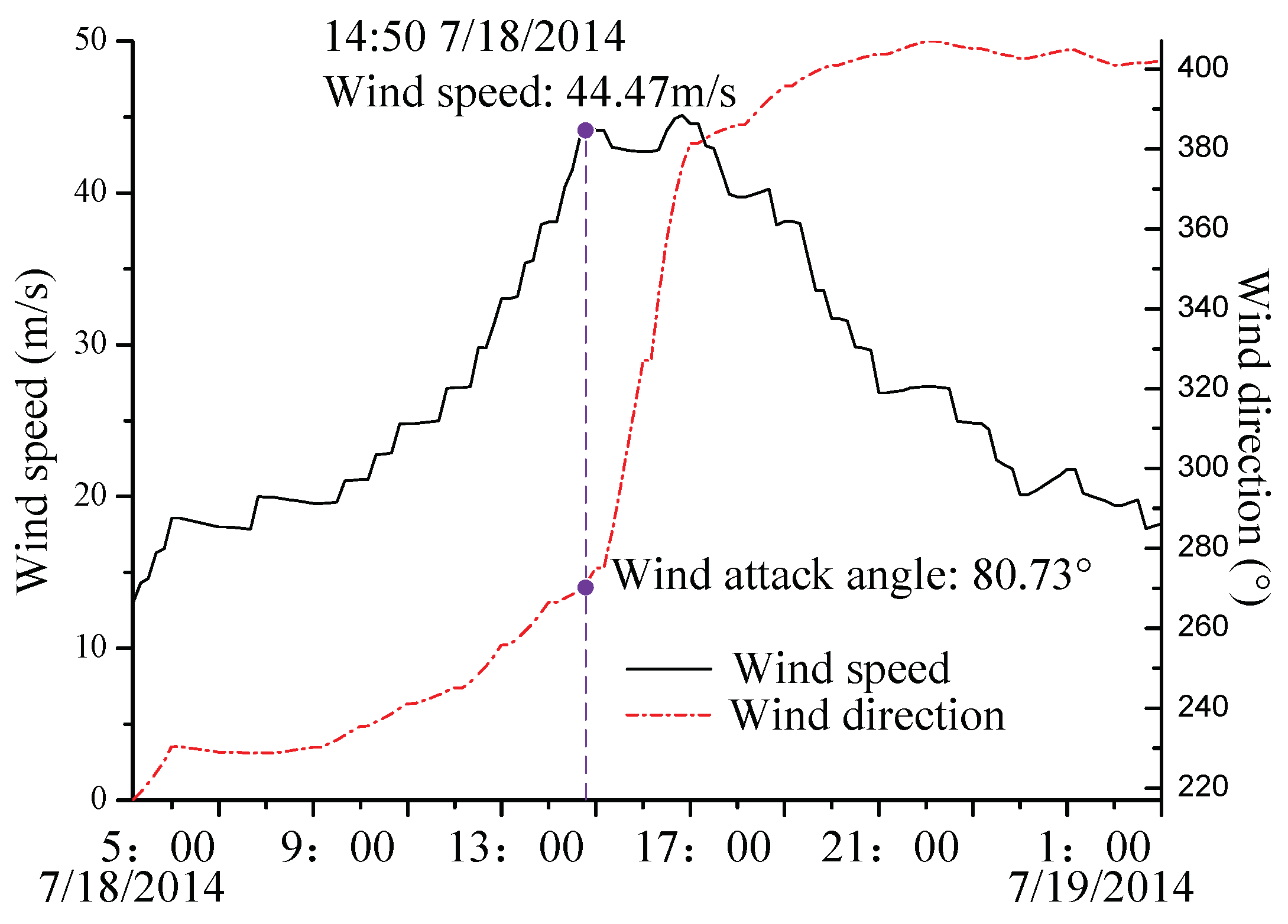
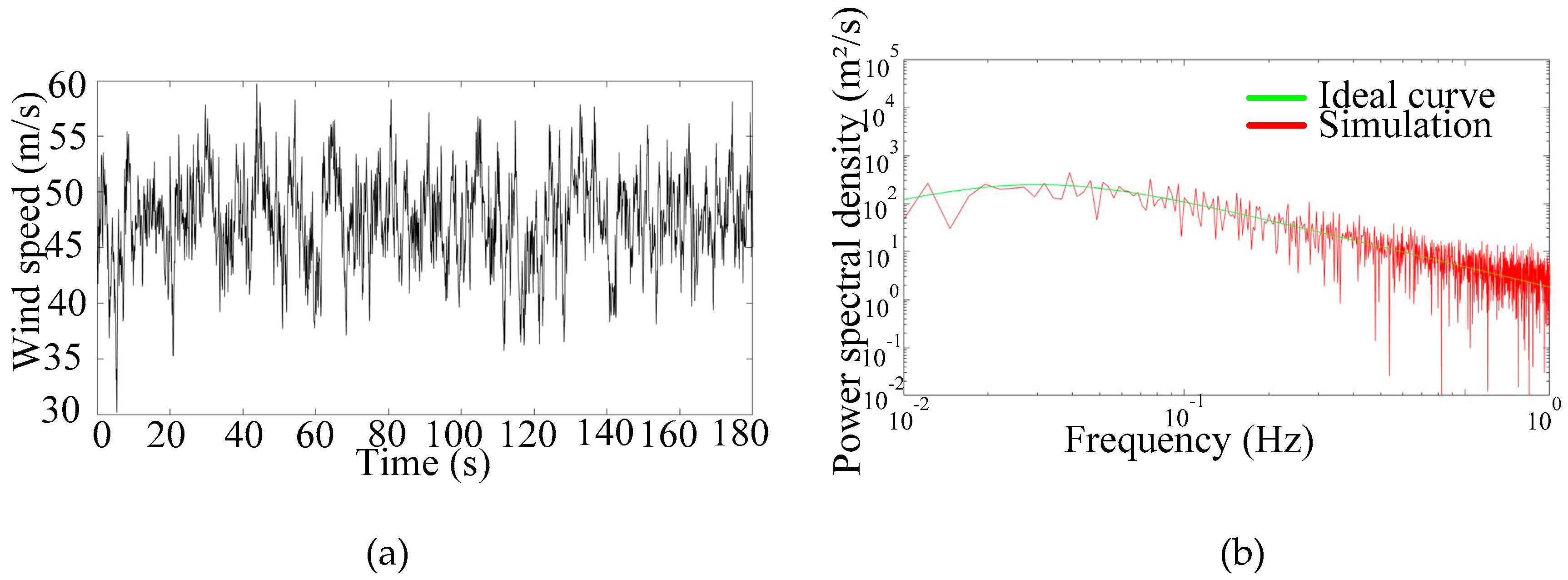
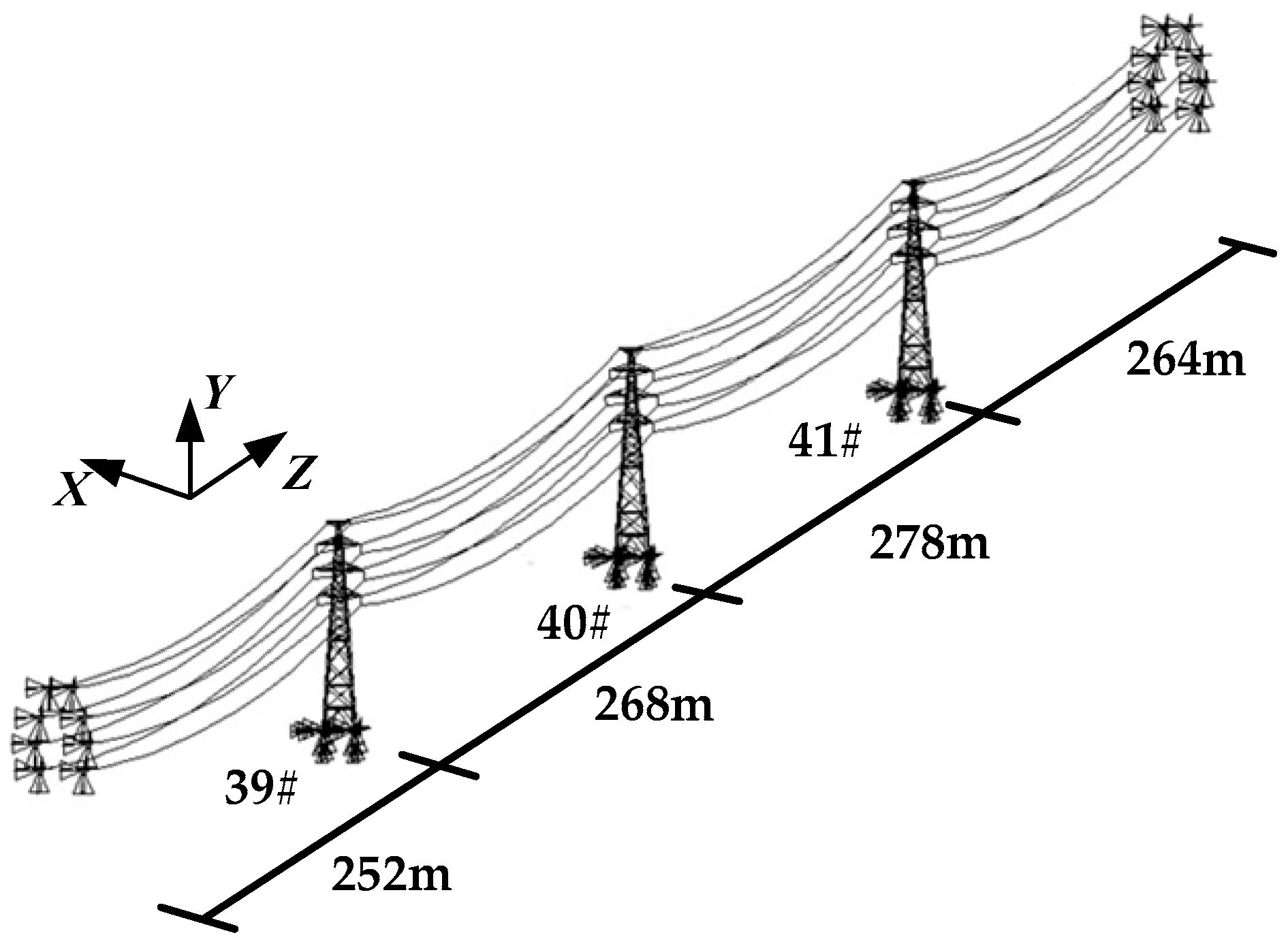
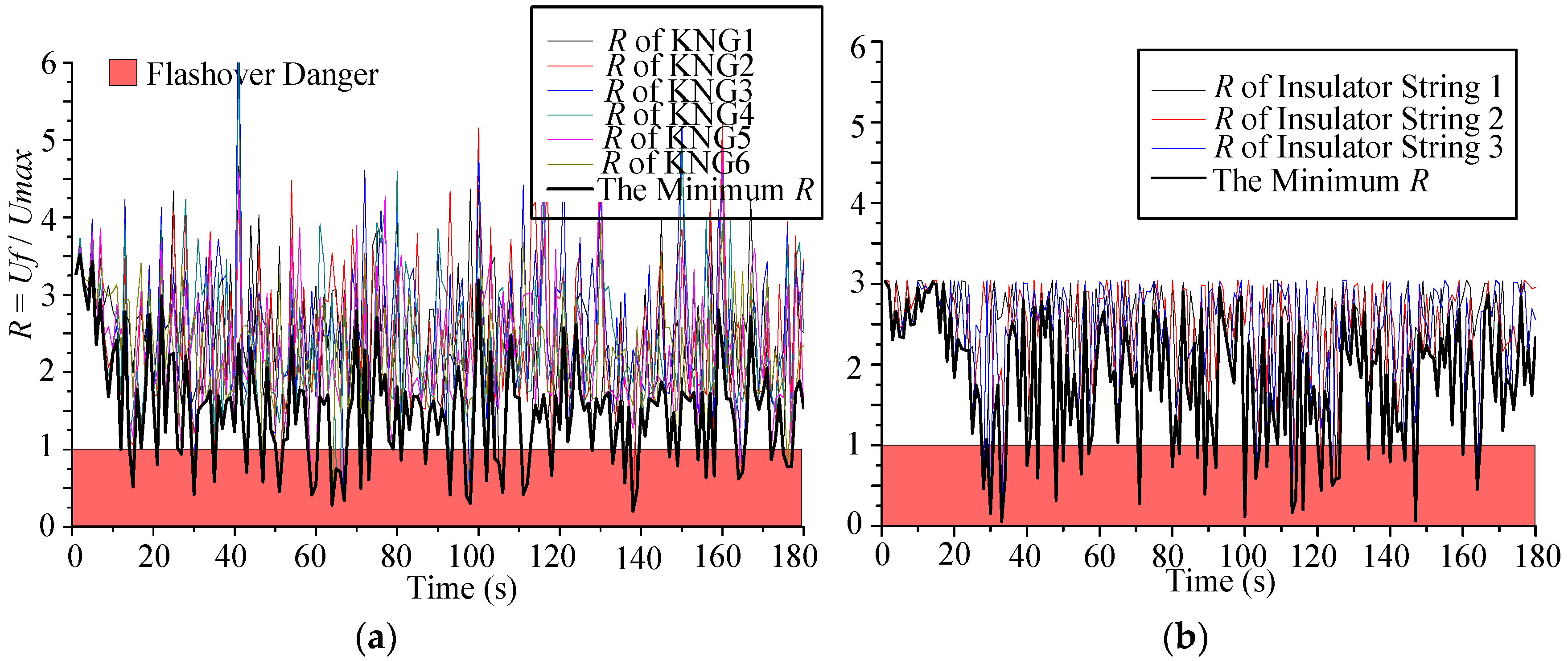


| Rainwater Density ρr (mm/h) | a1 | a2 | a3 | SSE | RMSE |
|---|---|---|---|---|---|
| 144 | −0.7166 | 1.399 | 0.2337 | 1.647 × 10−7 | 4.058 × 10−4 |
| 288 | −0.6966 | 1.381 | 0.2077 | 5.309 × 10−8 | 2.304 × 10−4 |
| 576 | −0.6994 | 1.405 | 0.1656 | 1.207 × 10−5 | 3.474 × 10−3 |
| 864 | −0.6865 | 1.391 | 0.1555 | 5.505 × 10−6 | 2.346 × 10−3 |
| Composite Insulator Type | FXBW4-110/100 |
|---|---|
| Rated voltage (kV) | 110 |
| Rated mechanical tensile load (kN) | 100 |
| Structural height (mm) | 1240 ± 15 |
| Minimum arc distance (mm) | 1015 |
| Minimum nominal creepage distance (mm) | 3150 |
| Lightning full-wave withstand voltage (kV) | 550 |
| Power frequency withstand voltage (kV) | 230 |
| Type | JL/LB1A-240/40 | JLB23-50 |
|---|---|---|
| Area (mm2) | 277.74 | 49.86 |
| Diameter (mm) | 21.66 | 9.00 |
| Mass per unit length (kg/km) | 916.9 | 315.1 |
| Rated tensile strength (N) | 85,851 | 54,900 |
| Elastic modulus (N/mm2) | 69,990 | 141,300 |
| Linear expansion coefficient (1/°C) | 19.76 × 10−6 | 12.9 × 10−6 |
| Maximum working strength (N) | 30,207 | 16,486 |
© 2019 by the authors. Licensee MDPI, Basel, Switzerland. This article is an open access article distributed under the terms and conditions of the Creative Commons Attribution (CC BY) license (http://creativecommons.org/licenses/by/4.0/).
Share and Cite
An, L.; Guan, Y.; Zhu, Z.; Zhang, R. Research on Windage Yaw Flashovers of Transmission Lines under Wind and Rain Conditions. Energies 2019, 12, 3728. https://doi.org/10.3390/en12193728
An L, Guan Y, Zhu Z, Zhang R. Research on Windage Yaw Flashovers of Transmission Lines under Wind and Rain Conditions. Energies. 2019; 12(19):3728. https://doi.org/10.3390/en12193728
Chicago/Turabian StyleAn, Liqiang, Yongyu Guan, Zhijian Zhu, and Ronglun Zhang. 2019. "Research on Windage Yaw Flashovers of Transmission Lines under Wind and Rain Conditions" Energies 12, no. 19: 3728. https://doi.org/10.3390/en12193728
APA StyleAn, L., Guan, Y., Zhu, Z., & Zhang, R. (2019). Research on Windage Yaw Flashovers of Transmission Lines under Wind and Rain Conditions. Energies, 12(19), 3728. https://doi.org/10.3390/en12193728





